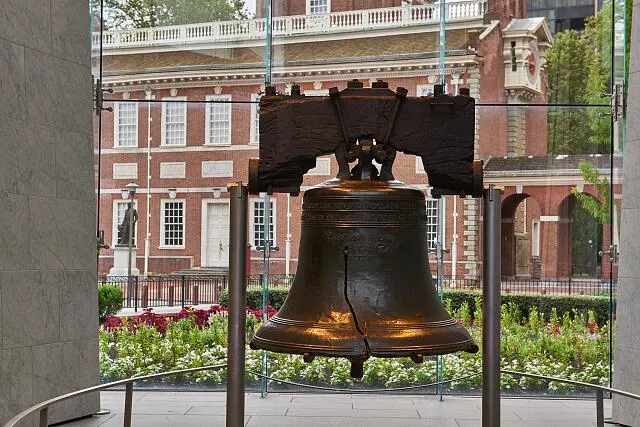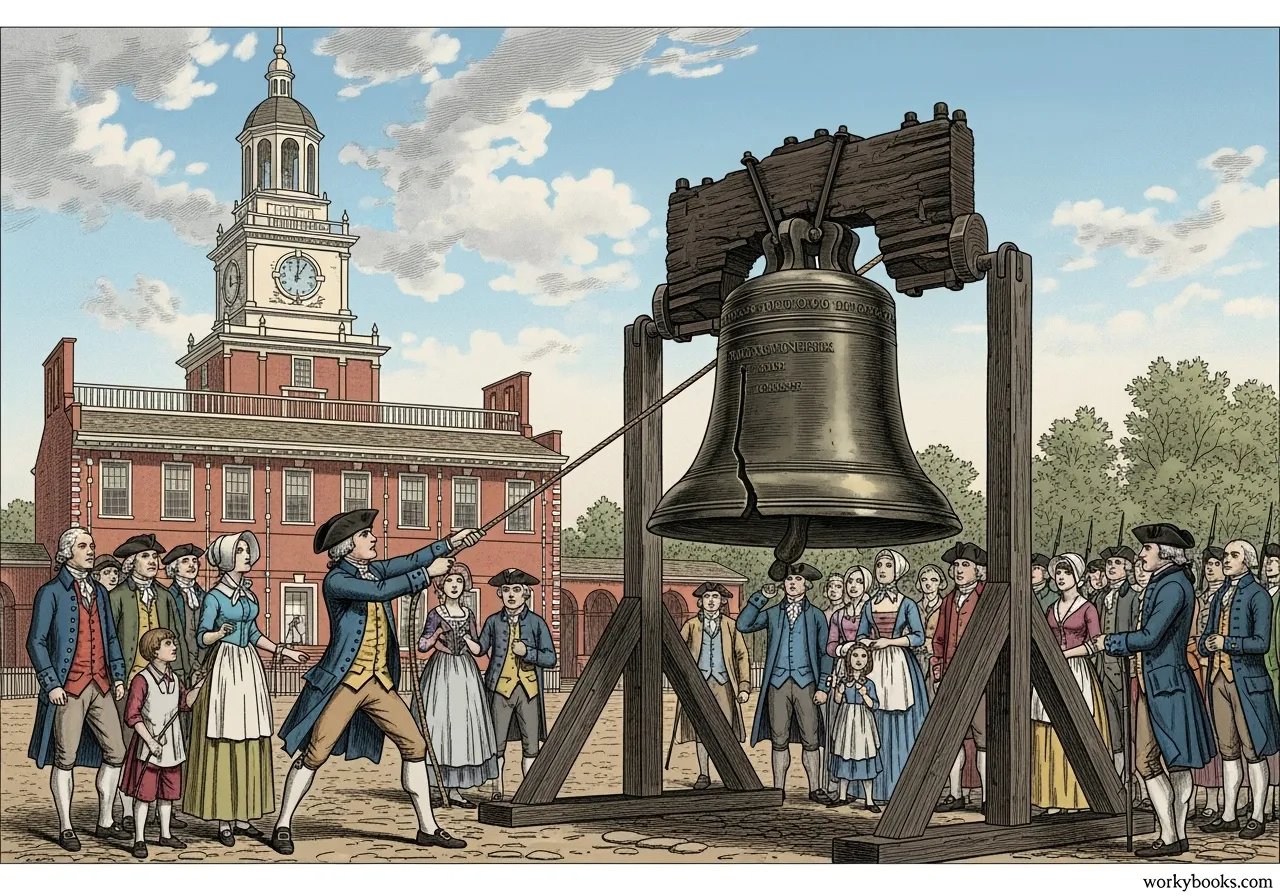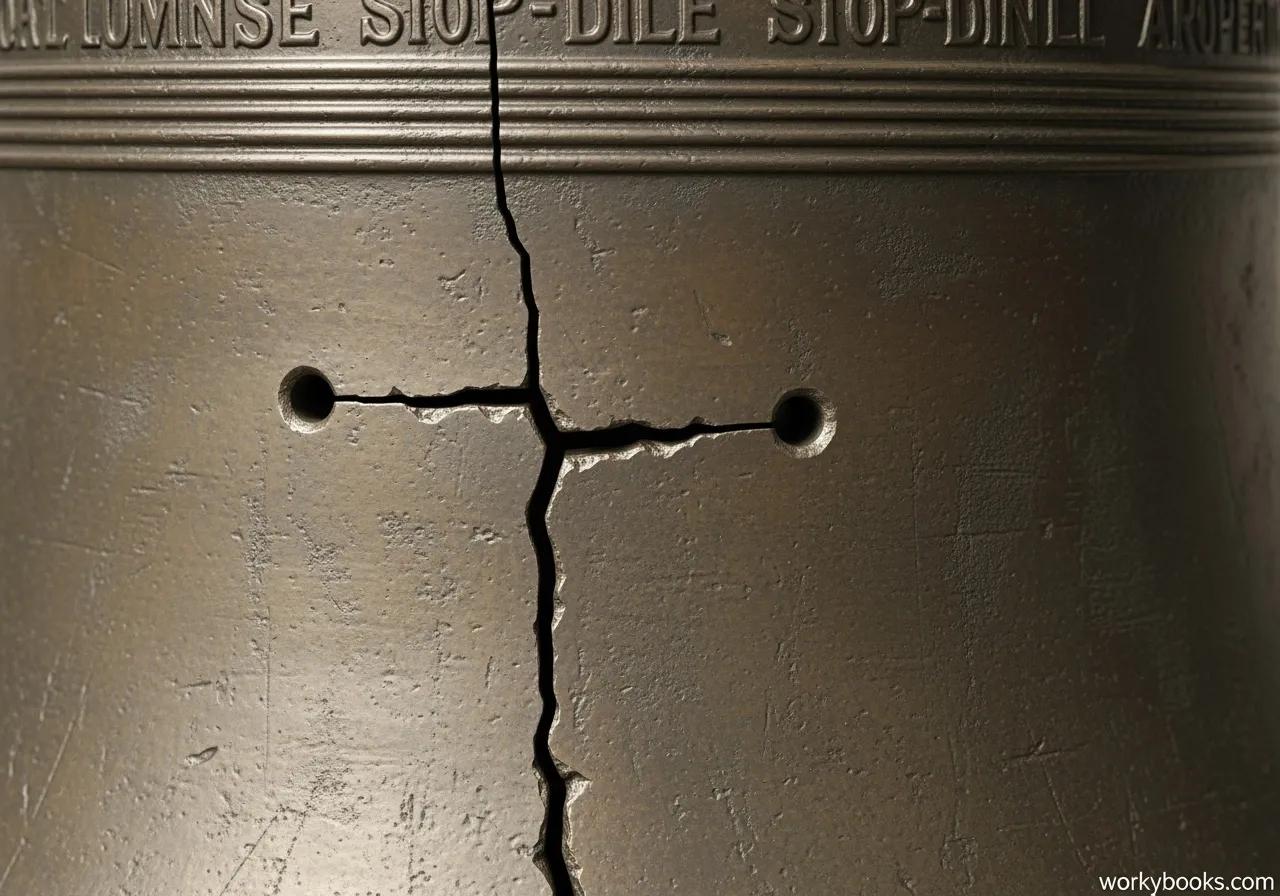Liberty Bell
Discover the history, meaning, and significance of America's iconic symbol of freedom!
What is the Liberty Bell?

The Liberty Bell is an important American symbol of freedom and independence. Located in Philadelphia, Pennsylvania, this historic bell is known for its distinctive crack. The bell was originally used to call lawmakers to meetings and to alert citizens about public announcements.
The Liberty Bell weighs about 2,080 pounds (943 kilograms) and is made mostly of copper and tin. It stands about 3 feet tall with a circumference of 12 feet around the bottom. The bell hasn't been rung since 1846, but it remains one of America's most cherished historical artifacts.
Did You Know?
The Liberty Bell wasn't always called by that name! It was originally known as the State House Bell. The name "Liberty Bell" became popular in the 1830s when abolitionists used it as a symbol in their fight against slavery.
History and Timeline

The Liberty Bell has a rich history that spans over 250 years. It was ordered in 1751 to commemorate the 50-year anniversary of William Penn's Charter of Privileges, which established rights and freedoms for Pennsylvania colonists.
The bell was cast in London, England, by the Whitechapel Bell Foundry and arrived in Philadelphia in 1752. Unfortunately, it cracked during testing and had to be recast twice by local artisans John Pass and John Stow before it was finally ready for use.
Bell Ordered
The Pennsylvania Assembly orders a bell for the State House (now Independence Hall)
First Crack
The bell arrives from London and cracks during testing
Recast
Local artisans John Pass and John Stow recast the bell twice
American Independence
According to tradition, the bell rang to announce the first public reading of the Declaration of Independence
Major Crack
The bell cracks severely while tolling for Chief Justice John Marshall's funeral
Last Ring
The bell is rung for George Washington's birthday, extending the crack and ending its ringing days
Symbol of Freedom
The bell travels across the country, becoming a national symbol of liberty
New Home
The Liberty Bell Center opens as the bell's current home
The Famous Crack

The Liberty Bell's crack is its most distinctive feature. The bell actually cracked multiple times throughout its history:
First Crack
The original bell cracked during testing in 1752, shortly after arriving from London
Recasting
Local artisans John Pass and John Stow recast the bell, adding more copper to make it less brittle
Major Crack
In 1835, the bell cracked severely while tolling for Chief Justice John Marshall's funeral
Final Ring
In 1846, the crack grew larger when rung for Washington's birthday, ending its ringing days
The crack measures about 24.5 inches long and 0.5 inches wide at its largest point. In the 1840s, drillers attempted to stop the crack from spreading by drilling holes at each end, creating what is now known as the "stop-drill" technique. This is why the crack has a squared-off appearance at both ends.
Why Did the Bell Crack?
The exact reason for the cracking is debated, but most historians believe the bell's metal was too brittle. The original composition was about 70% copper and 25% tin, which makes a hard but brittle alloy. When the bell was recast in America, more copper was added, but the fundamental brittleness remained.
Where is the Liberty Bell?

The Liberty Bell is located in Philadelphia, Pennsylvania, at the Liberty Bell Center in Independence National Historical Park. The Center is located at 526 Market Street, just across from Independence Hall where the bell originally hung.
The Liberty Bell Center opened in 2003 and was specifically designed to protect and display the bell. The building features large glass walls that allow visitors to see the bell from outside, and the interior includes exhibits about the bell's history and significance.
Visiting the Liberty Bell
The Liberty Bell Center is open to the public year-round, and admission is free. Visitors can see the bell up close and learn about its history through exhibits and park ranger talks. The bell is displayed in a special climate-controlled room to help preserve it for future generations.
What is Written on the Liberty Bell?

The Liberty Bell features a famous inscription from the Bible. Around the top of the bell, these words are cast in capital letters:
This passage comes from Leviticus 25:10 in the Bible. The verse continues: "It shall be a jubilee for you; each of you is to return to your family property and to your own clan." This refers to the Year of Jubilee, a time when slaves were freed and land was returned to its original owners.
Below this main inscription, the bell also bears three other lines of text:
- "BY ORDER OF THE ASSEMBLY OF THE PROVINCE OF PENNSYLVANIA FOR THE STATE HOUSE IN PHILAD"
- "PASS AND STOW / PHILAD'A / MDCCLIII" (the names of the recasters and the year 1753)
Meaning of the Inscription
The inscription made the bell particularly meaningful to abolitionists (people who fought to end slavery) in the 1830s. They saw the words "Proclaim Liberty" as a powerful message against slavery. This is when the bell first became known as the "Liberty Bell" and began its transformation into a national symbol of freedom.
Liberty Bell Quiz
Test your knowledge about the Liberty Bell! Answer all 5 questions to see how much you've learned.
Frequently Asked Questions
Here are answers to common questions about the Liberty Bell:
Liberty Bell Trivia
Discover amazing facts about the Liberty Bell!
Bell Weight
The Liberty Bell weighs about 2,080 pounds (943 kg). That's about as much as a small car! It stands 3 feet tall with a circumference of 12 feet at the bottom.
Metal Composition
The bell is made of approximately 70% copper, 25% tin, and small amounts of lead, zinc, arsenic, gold, and silver. The original bell had a different composition that made it more brittle.
Bell's Sound
When it could still be rung, the Liberty Bell's sound was described as sharp and clear with a distinctive tone that could be heard from several miles away on a quiet day.
Cross-Country Travels
Between 1885 and 1915, the Liberty Bell traveled to seven world's fairs and exhibitions, visiting cities like New Orleans, Atlanta, Chicago, Boston, and San Francisco.
Crack Dimensions
The famous crack is about 24.5 inches long and 0.5 inches wide at its largest point. The drilled holes at each end are about 1.25 inches in diameter.
Bell Replicas
There are dozens of full-size replicas of the Liberty Bell across the United States and around the world, including in Paris, France, and at the U.S. Capitol in Washington D.C.


